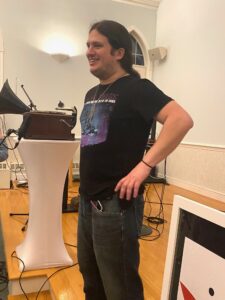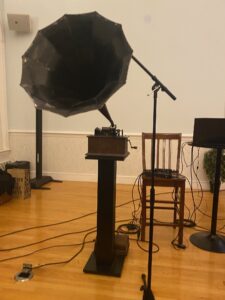Apr 1, 2024

Some 60 people turned out on March 4 to hear an entertaining and engaged Johnny Dalton, sound engineer, show and tell about key developments in the 166-year history of sound recording. Dalton graduated from Medfield High School in 2013 and established KungPow! Recording and Mastering in 2017.
Johnny introduced his subject by noting that, although Edison is popularly assumed to have invented sound recording, the first sound recording device, the phonautograph, was patented in 1857 by a Frenchman, Edouard-Leon Scott de Martinville.
The phonautograph consisted of a horn (think of a traffic cone) with a small diaphragm attached across the narrow end, with a stiff boar’s bristle firmly implanted in the diaphragm. De Martinville spoke or sang into the wide end of the horn, and the soundwaves would be concentrated onto the diaphragm, which would make the bristle vibrate and etch the squiggles onto a rotating cylinder coated with lampblack.
Thus soundwaves were first recorded in 1857. There was a catch – there was no way to turn the etched squiggles back into something audible – not until 2008, when scientists at Berkeley National Laboratory converted them into a digital audio file using IRENE technology. What did they hear? DeMartinville singing a French folk song called Au Clair de la Lune.

Some 20 years later Thomas Edison, while working to develop a machine that could transcribe telegraph messages, had the idea of recording sound by having the diaphragm attached to a stylus that would record up-and-down squiggles in tin foil. Then, for playback, another stylus would trace the ups and downs and cause the diaphragm to vibrate into the horn.
Hear for yourself: click here. And to hear the improvements over the following 25 years: click here.
Johnny has a sizeable collection of antique recording machines, and he demonstrated several machines to show the improvements in recording technology.

Initially, around the turn of the 20th century, these were toys for the fairly well-off. Recordings cost around $1 and players cost $50 on up – at a time when the average weekly earnings was around $10. But the prices came down rapidly, and Victrolas, as the record players were known, sold in the millions – so even today, a working Victrola doesn’t have much value as an antique.
Edison’s cylinder was ok for a start, but it had serious limitations, including a recording time limited to a few minutes, and they were hard to store.
Emile Berliner (1851-1929) made a significant step forward in the 1890s when he introduced the flat disc. It allowed for something to be recorded on both sides; it was easier to mass-produce; and it was easy to store in a furniture cabinet – especially one that already contained a record player. (Berliner also invented an early type of microphone for use in telephones, an early helicopter, what may have been the first radial aircraft engine, and acoustic tiles.)

Edison’s cylinders initially were superior in sound quality to discs, and he continued to improve them. But they were gradually overtaken by discs, though Edison stubbornly continued to make cylinders into the 1920s.
Another major improvement in sound recording took place in the 1920s, as advances in electronics led to radios, microphones, and amplifiers. Electrical recording replaced acoustic in short order.

Johnny also showed a Webster-Chicago wire recorder and an Ampex tape recorder. The first magnetic recording machine was demonstrated in 1898 in Denmark, and in the 1920s German engineers began serious development of tape recorders, known as Magnetophons. The Nazis used them in World War II.
At the end of the war, Americans recovered some and reverse engineered and improved them. The first American company to get into the business was founded about 1944 by a Russian émigré named Alexander M. Poniatoff. He used his initials and added “ex” for excellence; thus was born Ampex.
Johnny demoed a low-fi Webster-Chicago wire recorder from the 1940s that was suitable for use as a dictation machine.
But Johnny’s pièce de résistance was an Ampex open-reel tape recorder from about 1960 like the ones Elvis Presley bought and used. Johnny demoed it, and it sounded great!
Johnny Dalton was young and energetic presenter, and he drew a particularly enthusiastic round of applause from the crowd.
Photo credit: Colleen Sullivan